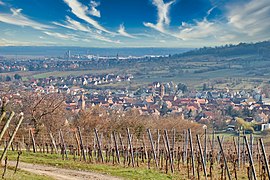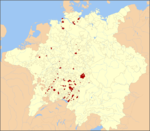world.wikisort.org - France
Rosheim (French pronunciation: [ʁosaim]; Alsatian: Rose) is a commune in the Bas-Rhin department in Grand Est in north-eastern France.[2]
This article may be expanded with text translated from the corresponding article in French. (December 2008) Click [show] for important translation instructions.
|
Rosheim | |
|---|---|
Commune | |
 View of Rosheim and surroundings | |
 Coat of arms | |
Location of Rosheim  | |
 Rosheim  Rosheim | |
| Coordinates: 48°30′N 7°28′E | |
| Country | France |
| Region | Grand Est |
| Department | Bas-Rhin |
| Arrondissement | Molsheim |
| Canton | Molsheim |
| Government | |
| • Mayor (2020–2026) | Michel Herr |
| Area 1 | 29.55 km2 (11.41 sq mi) |
| Population | 5,221 |
| • Density | 180/km2 (460/sq mi) |
| Time zone | UTC+01:00 (CET) |
| • Summer (DST) | UTC+02:00 (CEST) |
| INSEE/Postal code | 67411 /67560 |
| Elevation | 164–842 m (538–2,762 ft) |
| 1 French Land Register data, which excludes lakes, ponds, glaciers > 1 km2 (0.386 sq mi or 247 acres) and river estuaries. | |
Imperial City of Rosheim | |||||||||
|---|---|---|---|---|---|---|---|---|---|
| 1303–1679 | |||||||||
 Coat of arms
| |||||||||
| Status | Free Imperial City of the Holy Roman Empire | ||||||||
| Capital | Rosheim | ||||||||
| Government | Republic | ||||||||
| Historical era | Middle Ages | ||||||||
• First mentioned | 778 | ||||||||
• Imperial immediacy | 1303 | ||||||||
• Foundation of the Décapole | 1354 | ||||||||
• Awarded to France | 1648 | ||||||||
• Abolition of Décapole and of Rosheimer independence | 1679 | ||||||||
| |||||||||
It lies 25 km (16 mi) southwest of Strasbourg, on the eastern slopes of the Vosges mountains. It is a winemaking town on the tourist "Road of the Wines of Alsace" and the Route Romane d'Alsace ("Romanesque route of Alsace").
Geography
Distance from Paris 450 km, Strasbourg 25 km, Obernai 7 km, Molsheim 7 km.
History
Rosheim was first mentioned in a document in 778 as Rodasheim. In 1262 it received its town charter, combined with the right to build a town wall. From the 14th to 17th centuries, Rosheim was an Imperial City of the Holy Roman Empire, and founded the Décapole confederation with nine other Alsatian Imperial Cities in 1354, the goal was to maintain their rights. Like the other Decapolitan cities, it was awarded to France by the Peace of Westphalia and finally lost its independence under the Treaties of Nijmegen and was annexed by France.
Population
| Year | Pop. | ±% p.a. |
|---|---|---|
| 1968 | 3,291 | — |
| 1975 | 3,499 | +0.88% |
| 1982 | 3,766 | +1.06% |
| 1990 | 4,016 | +0.81% |
| 1999 | 4,548 | +1.39% |
| 2007 | 4,721 | +0.47% |
| 2012 | 4,891 | +0.71% |
| 2017 | 5,149 | +1.03% |
| Source: INSEE[3] | ||
Sights
- Church Saint-Pierre-et-Paul (building 12th century, tower 14th century, organ 18th century)
- Church Saint-Etienne (18th century, belltower 12th century)
- Maison païenne (“pagan house”, 12th century)
- City Hall (18th century)
- Old well (Puits aux six seaux) (17th century)
- Four fortified tower-gates (13th and 14th century)
- Half-timbered houses (16th century)
Notable people
- Heinrich Eggestein (ca. 1415–88), pioneering book printer
- Jean-Marie Lehn (born 1939), Nobel Prize 1987
- Claude Vasconi (born 1940), architect
See also
References
- "Populations légales 2019". The National Institute of Statistics and Economic Studies. 29 December 2021.
- INSEE commune file
- Population en historique depuis 1968, INSEE
External links
На других языках
[de] Rosheim
Rosheim ist eine französische Stadt im Département Bas-Rhin in der Europäischen Gebietskörperschaft Elsass und in der Region Grand Est mit 5221 Einwohnern (Stand 1. Januar 2019).- [en] Rosheim
[es] Rosheim
Rosheim es una localidad y comuna francesa situada en el departamento del Alsacia, en Gran Este.[ru] Росайм
Росайм (фр. Rosheim) — коммуна на северо-востоке Франции в регионе Гранд-Эст[1] (бывший Эльзас — Шампань — Арденны — Лотарингия), департамент Нижний Рейн, округ Мольсем, кантон Мольсем[2].Другой контент может иметь иную лицензию. Перед использованием материалов сайта WikiSort.org внимательно изучите правила лицензирования конкретных элементов наполнения сайта.
WikiSort.org - проект по пересортировке и дополнению контента Википедии

